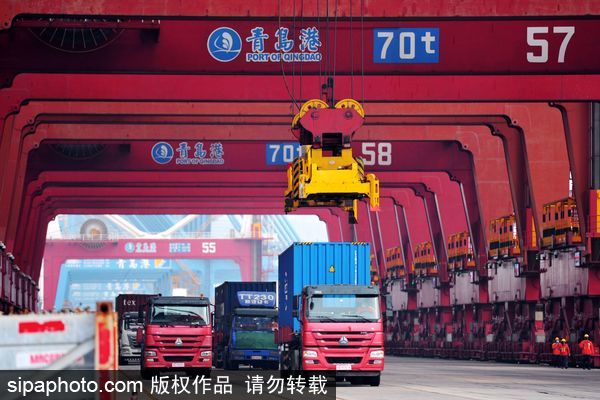Shandong foreign trade totals 278.08b yuan in first two months
(chinadaily.com.cn)| Updated : 2020-03-12
Print PrintCustoms authorities said the value of Shandong's foreign trade in the first two months of the year totaled 278.08 billion yuan ($39.57 billion), down 7.9 percent from the same period last year.
The province's exports totaled 138.76 billion yuan, down 11.7 percent, while imports totaled 139.32 billion yuan, down 3.7 percent.
Statistics showed that ASEAN(Association of Southeast Asian Nations)was the largest export market for Shandong in the first two months, with a trade volume reaching 35.07 billion yuan, up 12 percent year-on-year and accounting for 12.6 percent of the province's total.
The European Union (excluding the UK) was Shandong's second largest trading market, with imports and exports valued at 27.46 billion yuan, down 7.7 percent and accounting for 9.9 percent of Shandong's total foreign trade.

Trucks are loaded with containers at the foreign trade container terminal at Qingdao Port in Shandong province. [Photo/sipaphoto.com]
In the same period, Shandong's imports and exports to countries and regions involved in the Belt and Road Initiative were valued at 90.33 billion yuan, up 11.3 percent and accounting for 32.5 percent of Shandong's total foreign trade.
Imports and exports of private enterprises in Shandong were valued at 187.52 billion yuan, down 0.3 percent and accounting for 67.4 percent of the province's total.
Imports and exports in the province processed through the customs cross-border e-commerce management platform were valued at 350 million yuan, up 50.7 percent.
Customs authorities said that the decline of Shandong's foreign trade in the first two months was due to the novel coronavirus epidemic and unscheduled factory shutdowns after the Spring Festival holiday.
According to local customs authorities, the impact of the epidemic on Shandong's foreign trade will be temporary. Both the central government and the Shandong government have introduced a series of policies and measures to stabilize foreign trade. With the continued decline of the epidemic and the reopening of factories, foreign trade is gradually returning to a normal development track.

 Insights from the 10th Nishan Forum
Insights from the 10th Nishan Forum  Confucian culture thrives: Integrating its wisdom into modern value
Confucian culture thrives: Integrating its wisdom into modern value  Confucianism's enduring influence: Shaping East, Southeast Asian civilizations
Confucianism's enduring influence: Shaping East, Southeast Asian civilizations